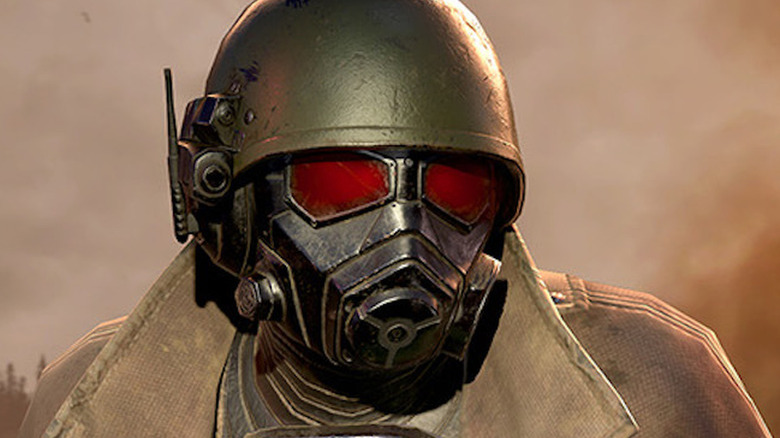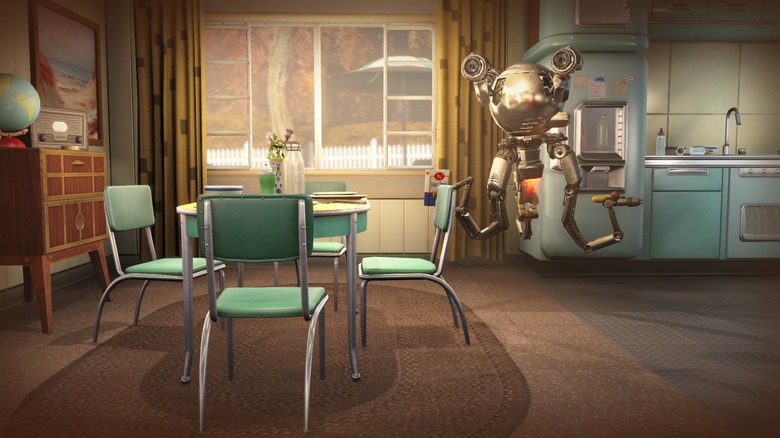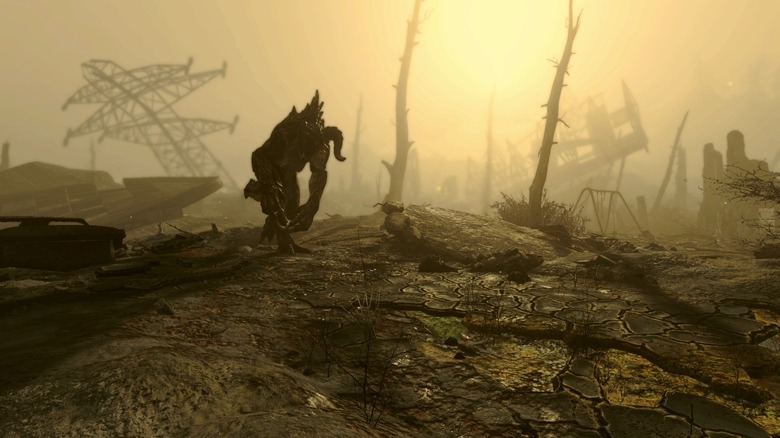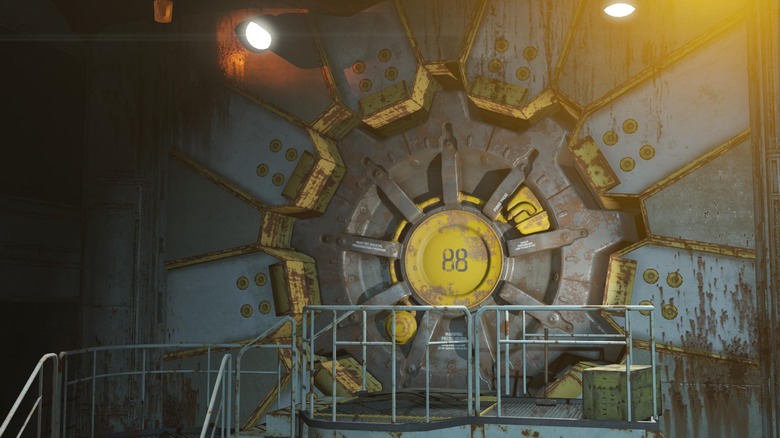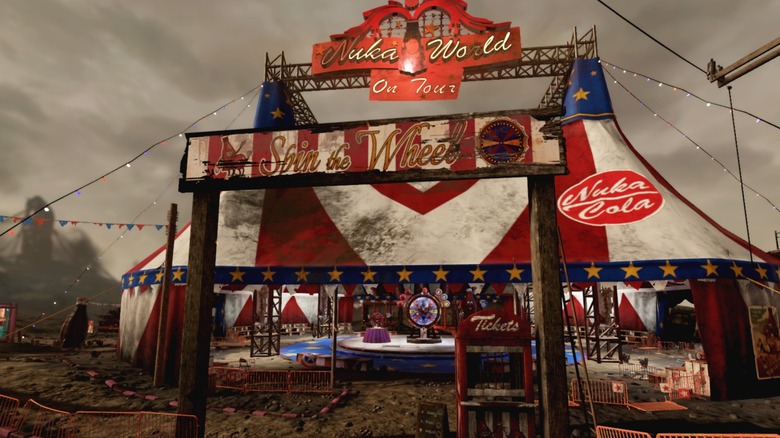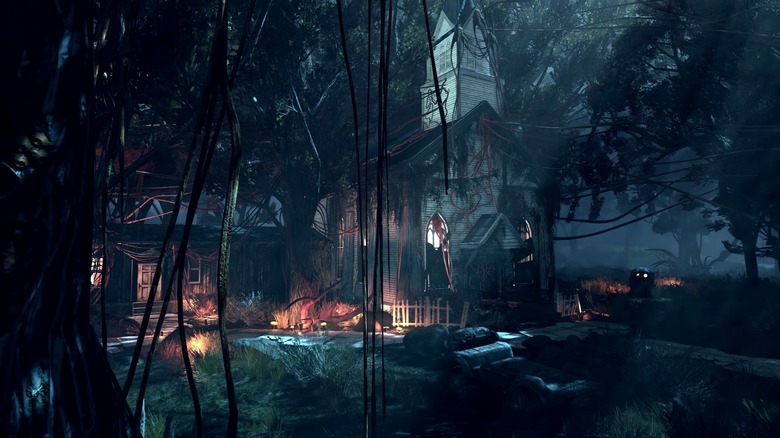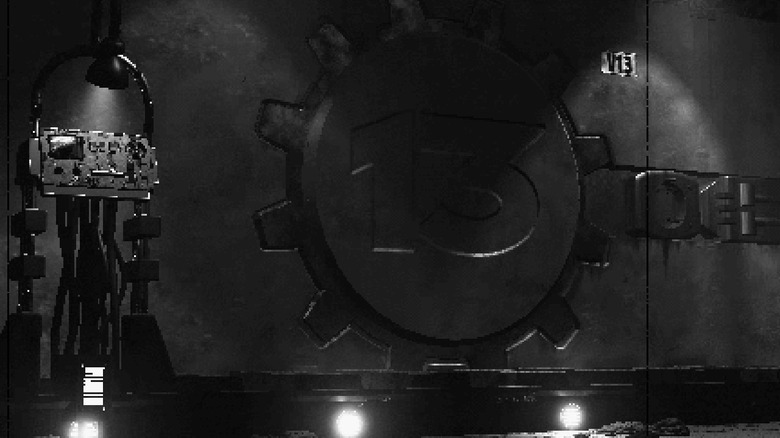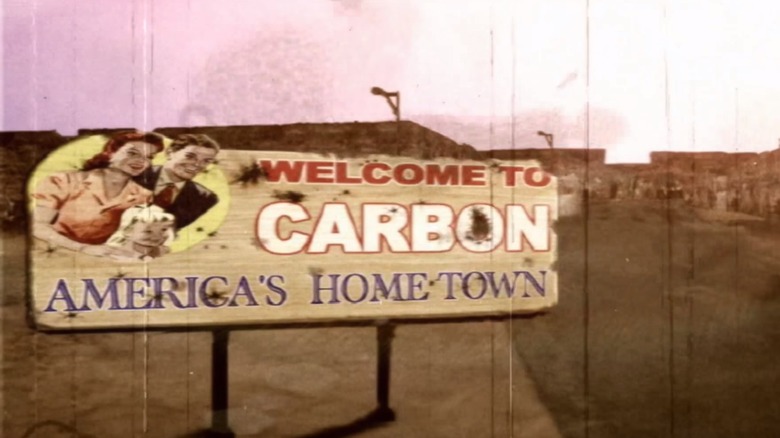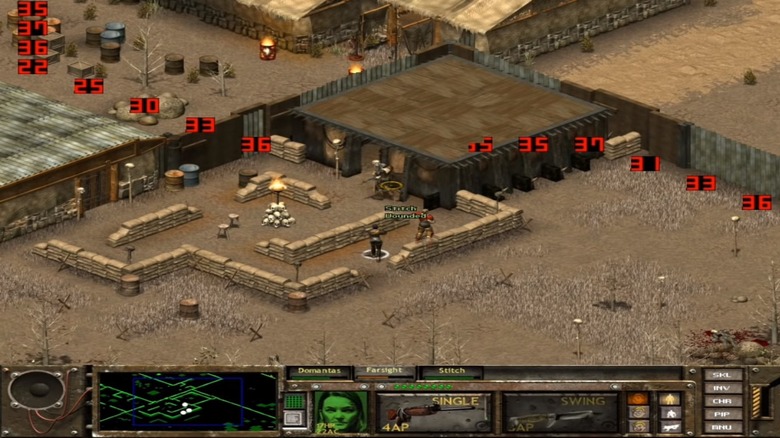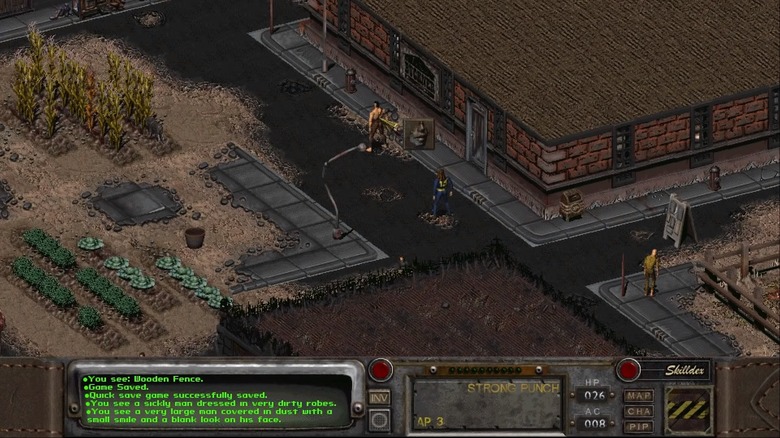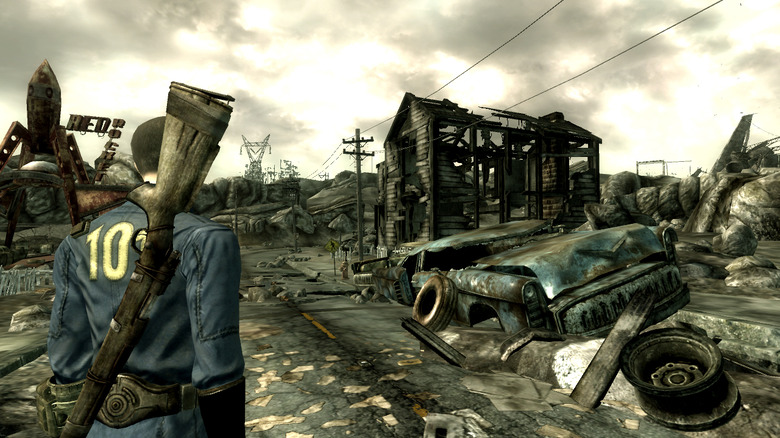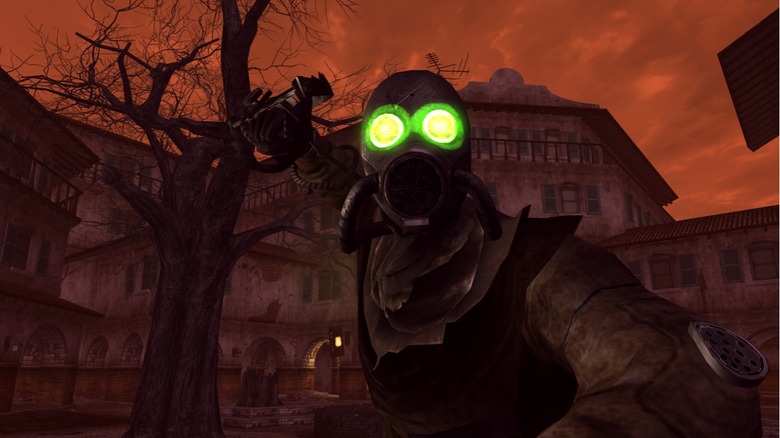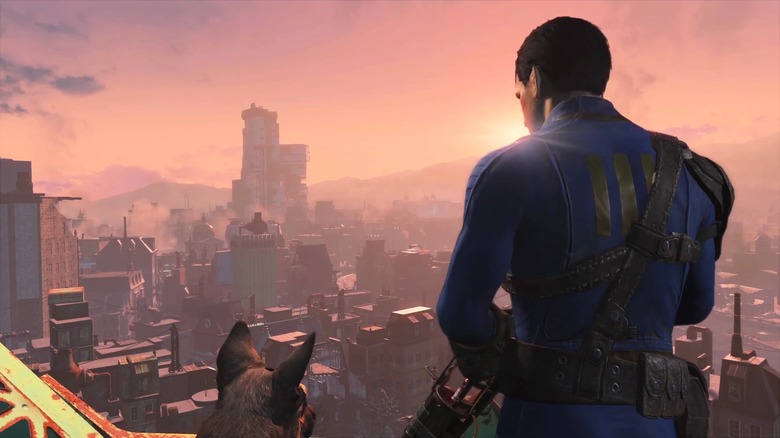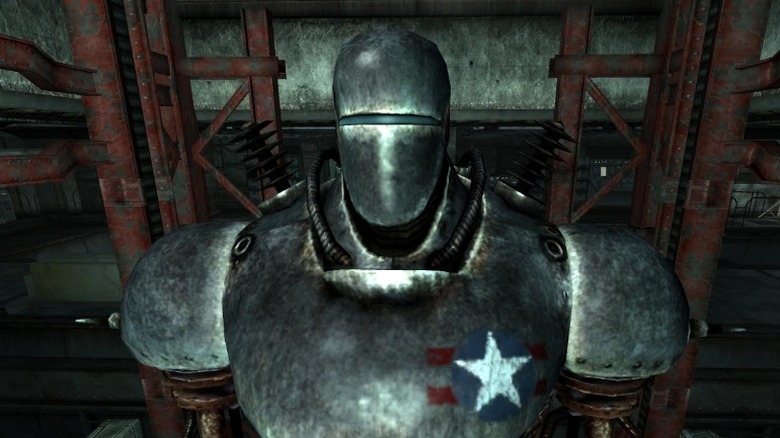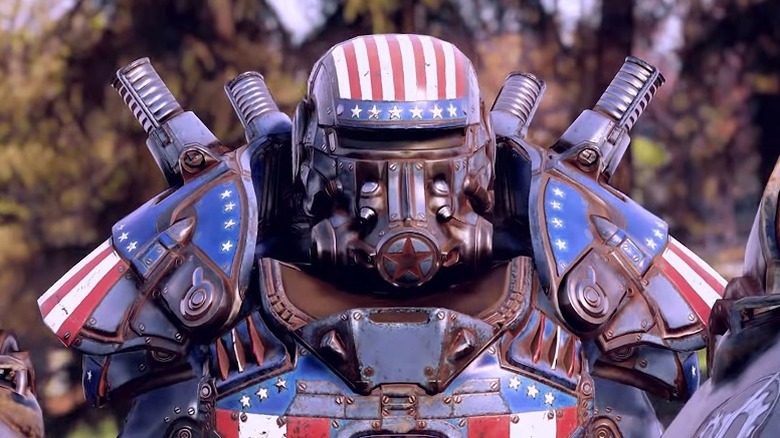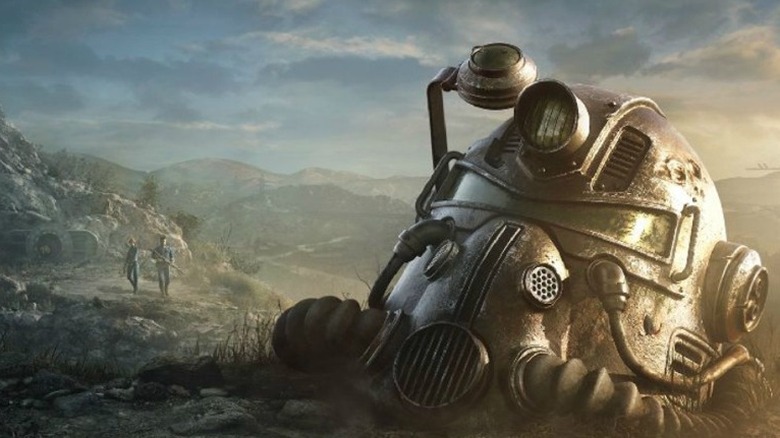The Bizarre Story Of Fallout Explained
Since the release of the first title in 1997, the "Fallout" series has become an iconic fixture of the gaming world. Like "Wasteland" and the "Mad Max" series, the franchise is one of the first to spring to mind when you think post-apocalyptic, a genre it has helped to define for the modern era.
Though the series has experienced its shares of difficulties, including a change of publishers, "Fallout" continues to deliver memorable gameplay experiences. With an intricate history, a host of well-developed factions, and cast of compelling characters, the series puts you at the center of humanity's fight for survival.
"Fallout" explores several concepts, many of which focus on the complexities of human nature. These themes, coupled with its robust setting, can make the series difficult to take in. Details get lost and plot threads tangle as you delve deeper into the uncanny mirror of reality the games present.
For those seeking to connect the dots, here is the bizarre story of Fallout explained.
The future is here
Though a post-apocalyptic series, "Fallout" puts a unique spin on this popular concept. Set in the 22nd century, the game couples the technological advances of the future with a 1950s aesthetic, evoking the nuclear paranoia of the United States following World War II. This retro-futuristic, alternate history storyline forms the core of the atompunk genre, which has close ties to steampunk, cyberpunk, and raygun gothic.
The series' alternate timeline diverges from the real-world timeline in the mid-1940s. To combat the growing influence of Communism, the US government divided the country into 13 commonwealths. Technological advances such as robots and energy weapons emerged while the development of supercomputers and miniaturized electronics was neglected.
Though there were no international conflicts for decades, the dwindling of energy resources in the mid-2000s led to the collapse of several countries. The nations left standing battled for the remaining resources, leading to an 11-year war with China fought over the crude oil reserves in Alaska.
Though the Americans reclaimed Alaska in 2077, hostilities had reached their breaking point. Later that year, this hatred culminated in the Great War, a two-hour nuclear exchange that bathed the world in fire and pushed humanity into a nuclear Dark Age of its own making.
Welcome to the Wasteland
Following the mass devastation of the Great War, the world devolved into the Wasteland. Scarred by radiation and depopulation, resources and necessities grew scarce. Cities fell into decay though rare areas withstood the apocalypse relatively intact.
Some humans caught in the radiation survived the exposure, though they were forever transformed. Zombie-like beings with rotting skin, these ghouls, also called necrotic post-humans, formed a new group of people. The conflicts and discrimination between the humans and the ghouls remain key themes of the series.
In the years after the Great War, the survivors struggled against the unforgiving circumstances of their new reality. Gangs and bandits fought over what resources remained, preying on the weak and unprotected. Those who escaped the attention of these groups faced other threats, fending off mutants, malfunctioning machines, raiders, and radiation exposure.
Despite these challenges, new societies emerged in those areas still capable of supporting life. These meccas included parts of California, Nevada, Massachusetts, and West Virginia. Unlike the desolate environments of the rest of the country, these locations developed infrastructure, trade routes, and broadcast systems.
Project: Safehouse
In 2054, the US government initiated Project: Safehouse, partnering with Vault-Tec to build fallout shelters (called vaults) across the country. Though officially advertised as a way to protect US citizens from nuclear holocaust, they built only 122 vaults of the estimated 400,000 needed to protect the full population.
Rather than serving their advertised function, the US government used these vaults to conduct social experiments on pre-selected portions of the population. Additional private vaults were commissioned, though this number remained a carefully guarded secret.
Of the 122 public vaults constructed, only 17 served the promised function. These 17 served as a control group against which the government could measure the success of the unique vaults. Despite supposed good intentions, such as ending disease, the government used unethical methods for achieving results. They exposed the unwitting vault dwellers to many dangers, most of which proved fatal.
Vault-Tec conducted a variety of experiments. Vault 11 tested human nature, requiring the residents to sacrifice one person each year. They designed Vault 12's door not to close properly, leading to the formation of a large ghoul settlement called the Necropolis. 999 women and one man inhabited Vault 69, while Vault 77 housed one man and a crate full of puppets.
Though the 17 control vaults proved successful overall, most of the experimental vaults were failures, ending in insanity, suicide, or mass murder.
The constants of the Fallout series
The world of "Fallout" has seen players explore many different locations across the United States and encounter a wide array of different characters and organizations. However, there are also some common elements that are present throughout all of the games. Perhaps the most obvious of these are the Vaults themselves. These facilities are where the majority of the series' protagonists come from.
Then, of course, there is the Pip-Boy, a device manufactured by RobCo Industries. It is essentially a wearable computer that operates as an in-game menu and can perform a variety of functions, from showing a map of the area to powering the sophisticated V.A.T.S. system. With a retrofuturistic design, it is one of the most recognizable gadgets in the franchise.
Another constant presence in the "Fallout" series is Nuka Cola, a popular beverage that can be found throughout the wastelands of the United States. The bottles are so widespread that the caps are the de facto currency in the post-apocalyptic world. Similarly, Grognak the Barbarian comics are scattered throughout most of the titles, as can evidence of alien beings known as Zetans. Although they never directly impact the ongoing narrative, this extraterrestrial civilization abducts humans and items, experimenting on them for their own purposes.
Fallout 76 - The control vaults open
"Fallout 76" is set in 2101, 25 years after the Great War. As of November 2018, it was the latest entry into the series, though the earliest in the timeline, making it a prequel to the original games. The game takes place in Appalachia, an area in West Virginia that remained mostly intact after the earth-shattering events of 2077. You play as the Resident as they emerge from Vault 76, one of the 17 control vaults in the vault experiment.
The story follows the celebration of Reclamation Day, leading to the vault's scheduled opening. The plot focuses on tracking down the Vault 76 overseer, whose voice recordings and resources you discover throughout your journey. As the quest unfolds, you discover that most of the inhabitants of the area survived, only to be wiped out by the Scorched Plague. This plague created a new strain of semi-intelligent ghouls, bereft of individual consciousness yet linked by hostility and a feral hive-mind. Despite their condition, the Scorched maintain fine motor skills and the ability to use weapons.
The Scorched comprise the main threat of Fallout 76, though Appalachia is rife with dangers, including other Vault 76 inhabitants. As you continue to chase after the overseer, it eventually becomes clear you will have to nuke part of Appalachia to wipe out the Scorched threat. Only then can you and the former vault dwellers recolonize the area.
Fallout - An epic tale of water recycling
"Fallout" was the first entry into the series and takes place in Southern California in the year 2161, 84 years after the Great War. Though much of the area was devastated during the conflict, the survivors slowly eked out new settlements, leading to the formation of New California.
While the new state emerged, Dr. Richard Grey led an expedition to the Mariposa Military Base. The American military originally used the base to develop counters to genetically engineered super viruses. This led to the creation of the Forced Evolutionary Virus.
Upon reaching the base, Dr. Grey found it abandoned, only to have much of his team killed by the automatic defense systems. One of two survivors, he was accidentally knocked into a vat of FEV, leading to his rapid mutation and development of psychic powers. Conducting his own experiments, Grey, now called the Master, created an army of super mutants known as Unity.
In Fallout, you play as the Vault Dweller, an inhabitant of Vault 13. When the vault's water chip, which regulates water filtering and recycling, breaks, the Vault Overseer sends you out to find another one. You initially have 150 days to complete the quest before the Vault's water supply runs dry.
After retrieving the water chip, you're sent to deal with Unity's threat. Despite accomplishing this and several other good deeds, the Overseer ultimately exiles you to prevent the other inhabitants of Vault 13 from wanting to leave.
Fallout: Brotherhood of Steel - Fighting off super mutants
"Fallout: Brotherhood of Steel" takes place in Carbon, Texas in the year 2208. You have the option to play Cain, Cyrus, or Nadia, initiates of the Brotherhood of Steel. The Brotherhood arose from what remained of the United States military following the Great War. An organization of neo-knights, they are a quasi-religious group devoted to the veneration of technology and the eradication of mutants.
The first chapter of the game follows the Initiate as they search for missing Brotherhood members, leading them to the nearby town where they come in conflict with the town's mayor. After dealing with the mayor, the Initiate then saves the rest of the town's citizens from raiders. In the second chapter, they head to the city of Los with the help of the Vault Dweller from the original "Fallout" game. This search for mutants uncovers a cult called the Church of the Lost. After killing the church's leader, they pick up a trail pointing to a warehouse and a secret vault.
The third chapter centers on entering the vault and fighting the super mutant general, Attis. After receiving aid from the vault's human inhabitants, the Initiate fights their way to a computer terminal to start the vault's decontamination sequence. Using a monorail car, they manage to escape as the vault comes apart around them.
Released by Interplay Entertainment before Bethesda took the franchise over, "Brotherhood of Steel" is considered non-canon.
Fallout Tactics: Brotherhood of Steel - A mighty battle against a calculator
"Fallout Tactics: Brotherhood of Steel" (yes, it's almost the same name as the last game) follows a Midwestern Brotherhood of Steel initiate (the Warrior) and their squad. The plot begins with the Brotherhood's attempts to claim territory in the Chicago area and follows the Brotherhood's conflicts with various groups, including bandits, beastlords, mutants, and a robot army as they search for Vault Zero, the command center of the pre-War vault network.
After destroying a robot repair plant in Colorado, the Brotherhood discovers that Vault Zero is the origin point of the robot army. A figure known as the Calculator controls the army, later revealed to have resulted from the fusion of computers and human brains. Upon reaching Vault Zero in the Cheyenne Mountain, the Brotherhood uses a nuclear warhead captured earlier in the game to blast their way inside. They then fight their way to the Calculator's lair, destroying the brains that kept it alive.
The game has more than one possible ending. Your squad can destroy the Calculator or sacrifice a member to join with it, gaining access to its extensive data-banks of information. Any squad member can join with the Calculator, including the main character, with the chosen character's ethics guiding the machine's actions.
Another Interplay game, the main events of "Fallout Tactics" are considered semi-canon, with some references to it included in "Fallout 3" and "Fallout 4."
Fallout 2 - Starting anew
After the overseer exiled the Vault Dweller in Fallout, they traveled north with their companions, founding a tribal village in what was once Oregon. They later disappeared after completing their memoirs.
"Fallout 2" takes place in 2241, 80 years after the events of the original game. The player takes on the role of the Chosen One, a descendant of the Vault Dweller struggling to save their village, Arroyo, following multiple years of drought. The village elder sends the Chosen One to find a Garden of Eden Creation Kit and they eventually make their way to Vault 13. After getting the GECK, they return to find their village under Enclave occupation. A mysterious organization, you later uncover that the Enclave is what remains of the pre-War US government.
The Chosen One traces the Enclave's base to an offshore oil rig. Using an old oil tanker to reach the base, they discover the Enclave captured their tribesmen and the dwellers of Vault 13 to experiment on them using the Forced Evolutionary Virus.
The Vault Dweller destroys the oil rig and frees both the villagers and the Vault 13 dwellers. Together, they create a new community using the Garden of Eden Creation Kit.
Fallout 3 - Purifying the Potomac
"Fallout 3" takes place in 2277 on the East Coast of the United States, primarily in a region known as the Capital Wasteland. This is a location that spans the areas that were once known as the District of Columbia, Virginia, Maryland, and Pennsylvania. The game follows the Lone Wanderer who is forced to flee Vault 101 after their father, James, leaves and throws the vault into anarchy.
The plot centers on the Wanderer's journey as they search for James and uncover his work on Project Purity, a plan to purify the Potomac River using a massive water filter. James scrapped Purity following his partner's death, traveling to Vault 101 to raise their newborn in safety. The Lone Wanderer is also constantly accompanied by the voice of Three Dog on their journey, with the radio host not only offering quests to the character but also commenting on their actions and reputation within the wasteland.
After finding and freeing his father from a virtual reality program, the pair intend to use the information James uncovered to restart Project Purity; however, Enclave members invade the project site. James then floods the control room with radiation to stop the Enclave leader but kills himself in the process. The Wanderer travels to Vault 87 to find a Garden of Eden Creation Kit. The Enclave captures the Wanderer and takes them to their base. There, they learn of the Enclave leader's plan to use Project Purity to infect the water supply with a modified strain of FEV.
Escaping the base, the Wanderer reaches the Purity site with the help of the Brotherhood of Steel. Though they have all the needed components, activating the purifier requires entering a manual code in the radiation-filled control room. This forces the Wanderer to choose between sending a Brotherhood member to complete the task or making the ultimate sacrifice themselves.
Fallout: New Vegas - Don't shoot the messenger
"Fallout: New Vegas" takes place in a post-apocalyptic Las Vegas in 2281, four years after the events of Fallout 3, though its plot is largely unrelated.
You play as the mysterious Courier, with the game opening as they're ambushed while delivering a package from Primm to New Vegas. A mysterious man leads the ambush, taking the package before shooting the Courier and leaving them in a shallow grave. A robot named Viktor discovers the Courier, digging them up and taking them to Goodsprings where Doctor Mitchell rehabilitates them.
The game follows the Courier as they pursue their would-be assassin and centers on a three-way conflict between the New California Republic, Caesar's Legion, and Mr. House. Each faction maneuvers to control the still functional Hoover Dam which supplies the Southwest with clean water.
In the Mojave Wasteland where the game takes place, players also encounter a variety of tribal gangs. The Vipers, Khans, and Jackals all have their origins in New California's Vault 15 before they were driven eastwards due to skirmishes with other groups as well as the more powerful New California Republic's military forces and are a shadow of their former might.
The Courier tracks down their shooter, Benny, who is Mr. House's right hand. In a bid to seize control of New Vegas, Benny intercepted the package which was originally intending for his employer. The end of the game depends on player action. After taking their revenge, the Courier must choose a faction to side with in the final battle for the Hoover Dam. Depending on what they choose, they can either destroy the Dam, claim it for themselves, or place it in the hands of one of the three groups.
Fallout 4 - Sins of the Father
The events of "Fallout 4" occur in 2287 in the Commonwealth, a post-apocalyptic version of Boston. The game follows the Sole Survivor of Vault 111 as they try to find their son, Shaun.
Vault-Tec designed Vault 111 to test the effects of long-term cryogenic suspended animation. The staff lured unsuspecting citizens from nearby neighborhoods into the vault. Claiming they were for decontamination, the staff placed the subjects in stasis pods without their consent.
In 2227, the Survivor witnessed Shaun's kidnapping alongside the murder of their spouse. Trapped in a cryogenic pod, they could not intervene and were refrozen by the assailants. Later, after awakening from their 210-year stasis, they discovered that all the other inhabitants of the vault were dead. After escaping, the Survivor learns that the Institute, an advanced scientific organization, was behind Shaun's kidnapping. They took the infant to use as a source of pure human DNA for their third generation of advanced synthetic humans. Along the way, the player will come into contact with the Minutemen, a volunteer militia that aims to improve the lives of everyone in the Commonwealth, putting them in conflict with the Institute and the Brotherhood of Steel.
The Sole Survivor's search for his son leads to a startling discovery: Shaun, now an old man called "Father" has taken control of the Institute. In the wake of this reveal, the Survivor must work with or against Shaun, a choice that has a significant impact on the people of the Commonwealth. The Survivor can take a variety of companions along with them during this struggle, including the ever loyal German Shepard pup known as Dogmeat and the enigmatic private detective synthetic lifeform Nick Valentine, who can help track down Shaun and complete a wide array of tasks.
Connecting Fallout 3 and Fallout 4 together
While "Fallout 3" and "Fallout 4" tell two very different stories, the tales are somewhat connected. With just 10 years separating the two, a lot of common elements link them together. One of these is the Church of the Children of Atom, a religious cult that had its origins in the settlement of Megaton in the Capital Wasteland. Their sphere of influence expanded from that area following the events of "Fallout 3," with some members even arriving in the Commonwealth — where they can be encountered in and around Far Harbor.
Meanwhile, the underground organization known as The Railroad played a significant role in both games. The Lone Wanderer became aware of their struggle to free Synths from the Institute and this conflict continues a decade later, with Institute scientist Liam Binet leaking information to the Railroad to aid them in their mission. Over the course of "Fallout 4," The Sole Survivor can choose to ally with the Railroad or join the Brotherhood of Steel and the Institute in destroying them.
Another major connection between the two games is the giant U.S. Army robot Liberty Prime, a unit which was originally intended to fight Chinese invaders in Alaska during the Great War. Put into action by the Brotherhood of Steel after it was discovered hidden away in the Pentagon, the mech played a major role in defeating the Enclave at Project Purity. Following its destruction, it was rebuilt in Boston with the help of the Sole Survivor.
Fallout Shelter - Becoming an overseer
"Fallout Shelter" is a construction and management simulation game that allows the player to create their own vault and act as its overseer. Though non-canon, the title reveals a great deal about the nuances of vault life and design. As the overseer, you control all the vault's functions, including food, water, power, and the total inhabitants. To advance through the game, you must add and upgrade new areas before assigning dwellers to run each space. The game has 23 buildable rooms with functions such as living quarters, power generator, and water treatment. The more efficient the dwellers assigned to it, the better a room will run.
Vault dwellers form a key component of the game and are required to operate production rooms, to protect the vault from outside threats, and for reproduction. The population can increase via multiple methods, such as through birth or new dwellers showing up at random.
Wasteland exploration is another crucial part of the game. As the overseer, you can send groups of up to 25 dwellers to search for armor, weapons, and caps. Dwellers on missions sometimes even encounter locations from "Fallout 4."
Fallout Shelter also includes appearances by the Mysterious Stranger, a recurring character thought to be the father of the Lonesome Drifter from "Fallout: New Vegas."
The continuing story of Fallout 76
As something of a live service game, "Fallout 76" has received more post-launch content and updates than any other game in the franchise. That means that the story has continued to evolve and move forward as more DLC has become available to players. There have so far been more than a dozen updates released for "Fallout 76," although most of them don't have a significant plot advancement. One of the first to introduce new narrative elements was "Wastelanders."
Set a year after the events of the main story, "Wastelanders" sees human survivors return to Appalachia as rumors abound that the area is now safe and a valuable treasure has been hidden away. Much of the action focuses on how the Vault Dwellers from Vault 76 deal with the newcomers and try to discover the source of the rumors, as well as the conflict between the settling people and raiders who pose a threat to peace.
"Steel Dawn" is officially the sixth update for "Fallout 76" and sees the Brotherhood of Steel arriving in Appalachia following a long journey across the country. Led by Paladin Leila Rahmani, the group has to tread a fine line, carefully managing its relationship with Appalachia's new settlers, raider tribes, and the Vault 76 citizens. A sequel followed, "Steel Reign," which further explores the relationship of the Brotherhood of Steel with the rest of the inhabitants, as well as a conflict between Paladin Rahmani and Knight Shin over how much help they should offer in the ongoing fight against the Super Mutants.
The future of Fallout
The "Fallout" franchise shows no sign of slowing down, with multiple projects currently in the works. Longtime fans will be most concerned with the upcoming "Fallout 5," the next entry in the role-playing series. Speaking in 2022, Bethesda director and producer Todd Howard explained that the game would officially begin development following the release of "The Elder Scrolls 6" (via IGN). Considering that there is currently no firm release date for that game and that it likely won't arrive for some time, the next "Fallout" sequel is certainly a long way off yet. The studio also hasn't spoken about when it might be set or where the action will take place, so there's very little to go off right now.
One "Fallout" project that is a little more fleshed out is the upcoming Amazon Prime Video television series adaptation. Simply titled "Fallout," the post-apocalyptic show is being developed by Lisa Joy and Jonathan Nolan, the team behind the hit science fiction drama "Westworld" (via Deadline). Todd Howard is also involved in the series, which will chart the aftermath of a massive nuclear war that devastated the United States in 2077. "Justified" and "The Righteous Gemstones" star Walton Goggins is set to have a significant role, as will "Army of the Dead" actor Ella Purnell and "Twin Peaks" alumni Kyle MacLachlan.

